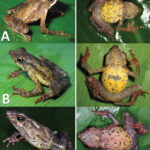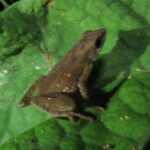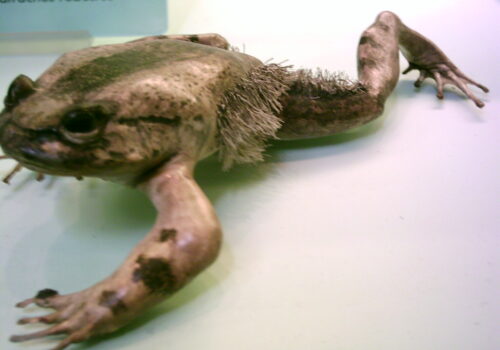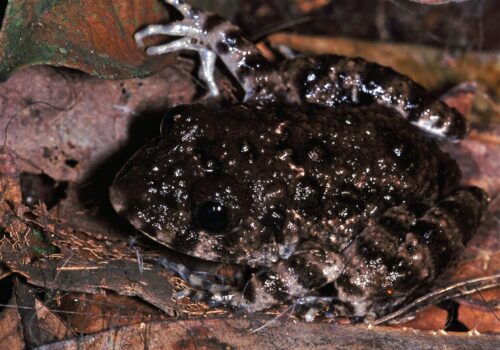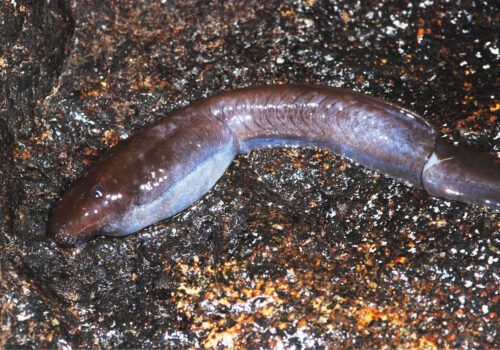- Exploring the Enigmatic Beauty of the Forest Tree Frog: Leptopelis bequaerti
- Taxonomy and Classification: Placing Bequaert's Forest Frog in Context
- Natural Habitat: The Verdant Canopies of Central Africa
- Physical Characteristics: A Masterpiece of Evolutionary Beauty
- Behavior and Life Cycle: Enchanting Harmonies of the Forest Night
- Ecological Role: Guardians and Indicators of Forest Health
- Threats and Conservation Status: Challenges in the Ever-Changing World
- Cultural and Scientific Significance: Symbols of Biodiversity and Ecological Wisdom
- Conclusion: Celebrating the Small Wonders of Nature
Exploring the Enigmatic Beauty of the Forest Tree Frog: Leptopelis bequaerti#
Hidden deep within the lush, verdant forests and thriving riverbanks of Central Africa, a small but exquisite amphibian thrives largely unnoticed by human eyes. This charismatic creature, the Bequaert’s forest tree frog (Leptopelis bequaerti), exemplifies the delicate balance between vibrant life and quiet survival in the region’s dense, tropical ecosystems. Though modest in stature and secretive by nature, Leptopelis bequaerti holds a special allure—its gentle murmur among the nighttime chorus hints at deeper tales of intriguing interactions, fascinating biology, and an essential ecological role.
Named in honor of the renowned Belgian naturalist Joseph Charles Bequaert, this charming frog belongs to a family famous for their expressive eyes, striking coloration, and distinctly arboreal (tree-dwelling) lifestyles. Yet beyond its captivating appearance lies an intricate life cycle and subtle adaptations that help scientists measure environmental health. Join me as we peel back the foliage to explore the elusive world of the splendidly secretive frog, shedding some well-deserved light on its remarkable life story and crucial conservation considerations.
Taxonomy and Classification: Placing Bequaert’s Forest Frog in Context#
Leptopelis bequaerti belongs to the Animalia kingdom and Amphibia class, nestled within the rich order of Anura—the frogs and toads. Further down this fascinating biological tree, it’s part of the Arthroleptidae family, a diverse group comprising colorful and slender species adapted to life above forest floors. Within this family lies the genus Leptopelis, boasting some of Africa’s most captivating tree frogs.
Close relatives of Bequaert’s tree frog include species such as Leptopelis viridis and Leptopelis uluguruensis, creatures that exhibit similar arboreal adaptations and mesmerizing behaviors. Despite their similarities, each species in this genus showcases unique variations in habits, appearance, and call patterns, emphasizing their distinct ecological roles and adaptations to their respective habitats.
Natural Habitat: The Verdant Canopies of Central Africa#
A Geographical Portrait#
Leptopelis bequaerti primarily inhabits the dense tropical forests within regions of Central Africa, with confirmed populations scattered across the lush territories of Cameroon, Gabon, the Democratic Republic of Congo, Equatorial Guinea, and adjacent regions. Preferring habitats filled with humid foliage and intertwined branches, the species represents a classic arboreal amphibian, expertly adapted for life in the heights of these green kingdoms.
A Life in the Leaves#
Fluttering leaves, intertwining branches, and shaded streams provide essential havens for Bequaert’s frog. Unlike ground-dwelling amphibians, Leptopelis bequaerti flourishes amidst vertical densely packed forests, spending much of its daylight hours gently tucked beneath broad-leaved plants or perched inconspicuously in shadowed tree bark hollows. The darkness of these shaded retreats provides protection against keen-eyed predators, while humidity maintains their delicate skin’s health.
After dusk, the quiet arboreal camouflage transforms into bustling nocturnal activity. Frogs navigate their aerial pathways with impressive agility, climbing and hopping confidently from leaf to leaf, branch to branch, often descending to lower vegetation near streams where they perform their nighttime symphonies to attract mates and hunt prey.
Physical Characteristics: A Masterpiece of Evolutionary Beauty#
Size and Form#
True to its arboreal identity, the Bequaert’s forest tree frog is a small, agile amphibian that rarely grows beyond approximately 45 millimeters, showcasing an elegantly streamlined physique. Its long hind legs, adhesive toe pads, and flexible limbs contribute enormously to its climbing mastery and precise jumping—a vital adaptation granting access from ground level vegetation up to the loftiest tree canopies.
Colors of Camouflage and Warning#
The visual attractiveness of Leptopelis bequaerti also holds functional evolutionary significance, with colors typically ranging from translucent greens and soft olives to subtle shades of brown and tan. Smooth skin often displays faint speckled patterns or scattered irregular markings that mimic damp leaves and moss-covered bark, greatly enhancing their camouflage capabilities. Subtle changes in color and texture allow frogs to blend seamlessly into their surrounding foliage, elegantly evading predators awaiting below or hunting from above.
Their remarkably expressive, gold-tinted eyes, shimmering slightly in moonlight, reflect the charismatic beauty and silent mystery inherent within these small forest guardians.
Behavior and Life Cycle: Enchanting Harmonies of the Forest Night#
Melodies and Courtship#
The nocturnal calls of Leptopelis bequaerti are distinctive and melodic, forming harmonious choruses in the vibrant night landscapes of their forest homes. Males sing gently from strategically selected perches—low bushes, branches, or leaves overhanging small streams—using their melodic calls to attract attentive females. Such delicate symphonies are central to the life cycle, setting the stage for essential courtship rituals and reproductive success.
A Journey from Egg to Froglet#
After successful courtship, females lay small clusters of gelatinous eggs laid carefully hidden within vegetation or near quiet bodies of water. Unlike many terrestrial frogs, tree frogs such as Leptopelis bequaerti produce well-protected eggs that hatch relatively quickly into agile tadpoles.
Hatched tadpoles swiftly dive underwater, feeding voraciously on algae, decomposing plant materials, and microorganisms that abound in forest streams, pools, and puddles. Over weeks and months, these legless larvae evolve slowly, sprouting limbs, absorbing their tails, and developing lungs, ultimately emerging as miniature replicas of their beautifully colored adult counterparts.
Ecological Role: Guardians and Indicators of Forest Health#
As predators of small insects like mosquitoes, flies, ants, spiders, and other arthropods, Bequaert’s frogs maintain insect populations, creating natural balance within their ecosystems. Because of their permeable, moisture-dependent skin, amphibians like Leptopelis bequaerti serve as important ecological indicators, easily succumbing to environmental changes due to pollutants, habitat fragmentation, and climatic shifts. Tracking their population health helps conservationists assess environmental impacts, enabling well-informed conservation strategies.
Threats and Conservation Status: Challenges in the Ever-Changing World#
An Enduring Battle Against Human Impacts#
Like many forest-dwelling amphibians of Central Africa, threats facing Leptopelis bequaerti primarily involve habitat destruction through deforestation, agricultural expansion, logging, and urbanization. Additionally, climate change introduces temperature fluctuations and irregular rainfall patterns, fundamentally disturbing the delicate microclimates required for successful breeding and survival of tadpoles and juveniles.
Current Conservation Efforts#
The International Union for Conservation of Nature (IUCN) currently classifies Leptopelis bequaerti as “Least Concern” thanks to its widespread distribution and relative population stability. However, this recognition doesn’t imply complacency. Localized threats continue to cause isolated declines, suggesting a strong imperative for ongoing monitoring, preservation of rainforest habitats, and advocacy aimed at sustainable development practices.
Cultural and Scientific Significance: Symbols of Biodiversity and Ecological Wisdom#
Beyond their ecological roles, amphibians stand as important cultural symbols across many African societies, often representative of regeneration, abundance, and environmental integrity. Scientifically, frogs like Leptopelis bequaerti provide crucial research opportunities, helping biologists comprehend broader environmental conditions, biodiversity interactions, evolutionary processes, and the broader impacts of global environmental change.
Conclusion: Celebrating the Small Wonders of Nature#
Every small frog hidden high amongst vibrant leaves underscores our duty to protect precious and fragile ecosystems. Bequaert’s forest tree frog embodies the irreplaceable charm, ecological value, and biological intrigue that inspire us to discover, respect, and preserve nature’s diversity. Join conservation endeavors, support sustainable actions, and let’s collectively cherish the quiet, melodious presence of frogs like Leptopelis bequaerti, amply affirming their pivotal importance within our breathtaking natural world.


